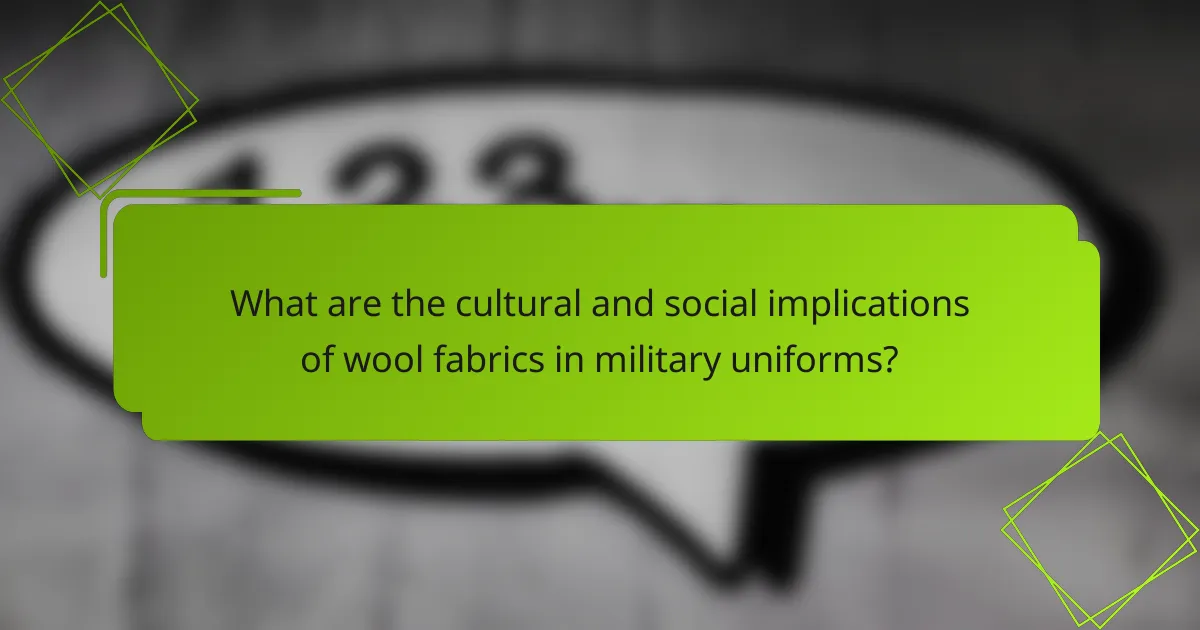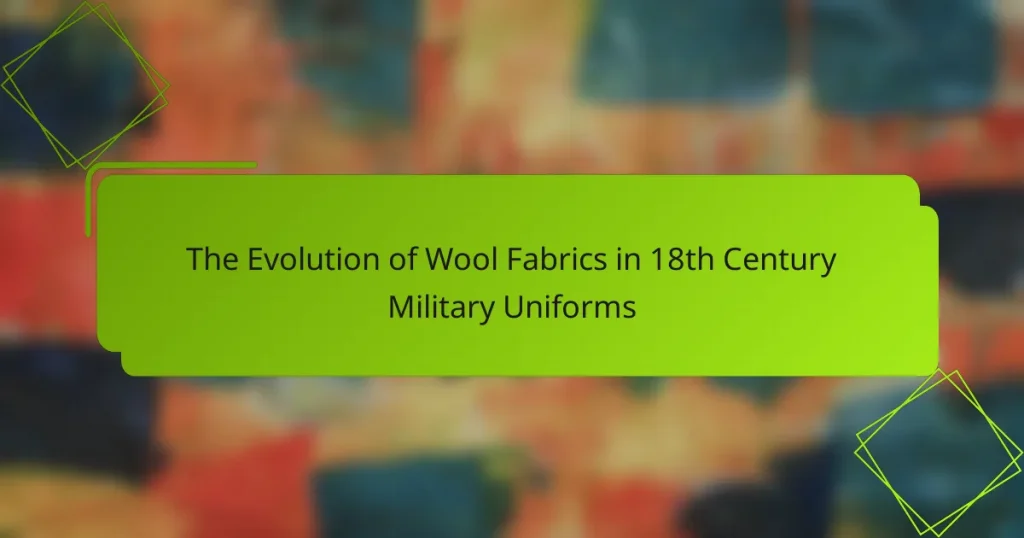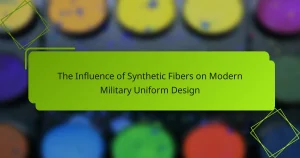The article focuses on the evolution of wool fabrics used in 18th century military uniforms, highlighting their durability, warmth, and moisture resistance. It discusses the characteristics of coarse wool, including its strength, tight weaving, and natural elasticity, which made it suitable for soldiers in various climates. The article also examines the impact of the Industrial Revolution on wool production, leading to higher quality and more affordable fabrics, as well as the influence of the rising middle class on uniform design. Additionally, it addresses the cultural significance of wool in military attire, emphasizing its role in fostering unity, discipline, and a shared identity among soldiers. Overall, the article provides a comprehensive overview of how wool fabrics shaped military uniforms during this transformative period.

What are the key characteristics of wool fabrics used in 18th century military uniforms?
Wool fabrics used in 18th century military uniforms were characterized by their durability, warmth, and resistance to moisture. These fabrics were typically made from coarse wool, which provided strength and longevity. The wool was often tightly woven, enhancing its protective qualities. Common colors included blue, red, and green, reflecting the regimental identity. The fabrics were also treated to improve water resistance, crucial for soldiers in various climates. Additionally, the wool had a natural elasticity, allowing for comfortable movement. The use of wool in military uniforms was prevalent due to its availability and suitability for outdoor wear. Historical records indicate that these characteristics made wool a preferred choice for military applications during this period.
How did the properties of wool influence military uniform design?
Wool’s properties significantly influenced military uniform design by providing durability, warmth, and moisture-wicking capabilities. The resilience of wool allowed uniforms to withstand harsh conditions. Wool’s insulating properties kept soldiers warm in cold climates. Additionally, wool can absorb moisture without feeling wet, maintaining comfort during long marches. The fabric’s natural elasticity contributed to a better fit and ease of movement. Historical records show that armies favored wool for its effectiveness in various weather conditions. For instance, British soldiers in the 18th century wore wool uniforms for these practical benefits. The use of wool became a standard choice for military attire due to these advantageous properties.
What specific attributes of wool made it suitable for military use?
Wool is suitable for military use due to its durability, insulation, and moisture-wicking properties. Its durability ensures that uniforms withstand harsh conditions and wear. Wool provides excellent insulation, keeping soldiers warm in cold environments. Additionally, wool can wick moisture away from the body, helping to regulate temperature. These attributes were crucial for soldiers in the 18th century, facing varied climates. Historical records show that wool uniforms were favored for their resilience and comfort during long campaigns. The combination of these qualities made wool a practical choice for military attire.
How did wool’s durability affect the longevity of military uniforms?
Wool’s durability significantly enhanced the longevity of military uniforms. Its robust fibers resist wear and tear, which is crucial for soldiers in demanding conditions. This durability allows uniforms to withstand harsh weather and rigorous activities. Historical records show that wool uniforms lasted longer than those made from other materials. For instance, during the Napoleonic Wars, wool uniforms remained functional despite extensive use. Additionally, wool’s natural resistance to moisture and fire contributed to their effectiveness. This made wool a preferred choice for military attire in the 18th century. Overall, the durability of wool directly correlated with the extended lifespan of military uniforms.
What were the common types of wool fabrics utilized?
The common types of wool fabrics utilized included broadcloth, serge, and melton. Broadcloth is a dense, tightly woven wool fabric known for its smooth finish. Serge is a durable fabric with a diagonal weave, offering strength and resilience. Melton is a heavy, felted wool fabric, often used for outer garments. These fabrics were chosen for their durability and ability to withstand harsh conditions. Historical records indicate that these materials were preferred in military uniforms for their practicality and warmth.
What variations of wool were preferred for different military branches?
Infantry units preferred fine wool for comfort and durability. Cavalry branches often used heavier wool for warmth and protection. Artillery units typically selected a blend of wool for flexibility and resilience. Each branch required specific wool variations to meet operational needs. Historical records indicate that infantry uniforms were often made from serge wool. Cavalry uniforms frequently featured broadcloth for its robust qualities. Artillery gear utilized melton wool for its heavy weight and wind resistance. These preferences were influenced by the climate and combat conditions faced by each branch.
How did the weight and weave of wool fabrics vary across uniforms?
The weight and weave of wool fabrics varied significantly across military uniforms in the 18th century. Different military branches and nations used specific wool types to meet functional needs. Heavier wool fabrics provided warmth and durability for colder climates. Lighter weaves allowed for better mobility and comfort in warmer conditions.
The weave patterns also differed, with some uniforms featuring tighter weaves for a more formal appearance. Others utilized looser weaves for breathability. For example, British Army uniforms often employed serge, a durable twill weave, while French uniforms might use lighter wool for ease of movement.
Historical records indicate that variations in weight and weave were influenced by both climate and tactical requirements. The choice of fabric was crucial for performance and soldier comfort during campaigns.

How did the evolution of wool fabrics reflect broader historical trends?
The evolution of wool fabrics in 18th century military uniforms reflected broader historical trends in industrialization and social class dynamics. As the Industrial Revolution progressed, advancements in spinning and weaving technologies improved wool fabric production. This led to the availability of higher quality and more affordable wool fabrics for military use.
The rise of the middle class during this period influenced military uniform design. Uniforms began to incorporate more elaborate styles and colors, showcasing the status of the military. Additionally, the need for standardized uniforms emerged as nations sought to create a cohesive military identity.
The use of wool also aligned with the growing emphasis on practicality and functionality in military attire. Wool’s durability and insulation properties made it ideal for soldiers in various climates. Thus, the evolution of wool fabrics mirrored the technological, social, and military transformations of the 18th century.
What role did technological advancements play in wool fabric production?
Technological advancements significantly improved wool fabric production. Innovations such as the spinning jenny and power loom increased the efficiency of spinning and weaving. These machines allowed for faster production rates and reduced labor costs. The introduction of carding machines improved fiber preparation, resulting in finer, more uniform yarns. Additionally, dyeing techniques evolved, enabling a wider range of colors and more durable finishes. Historical records indicate that these advancements contributed to the mass production of wool fabrics, meeting the growing demand for military uniforms in the 18th century. This increased availability and variety enhanced the quality and functionality of uniforms, essential for military use.
How did the Industrial Revolution impact wool fabric manufacturing?
The Industrial Revolution significantly transformed wool fabric manufacturing. It introduced mechanization, which increased production speed and efficiency. Spinning and weaving processes became automated with machines like the spinning jenny and power loom. These innovations reduced labor costs and improved fabric consistency. The availability of cheaper wool fabrics expanded market access. Additionally, the rise of factories centralized production, enhancing quality control. The overall output of wool fabrics surged, meeting the growing demand from various sectors, including military uniforms. Historical records indicate that by the mid-19th century, wool production had doubled compared to pre-industrial levels.
What innovations in dyeing and finishing processes emerged during this period?
Innovations in dyeing and finishing processes during this period included the introduction of synthetic dyes. These dyes offered a wider range of vibrant colors compared to natural dyes. The use of mordants improved color fastness and durability. Advances in textile finishing techniques enhanced the texture and appearance of wool fabrics. Techniques such as fulling and shearing became more refined. These innovations contributed to the overall quality of military uniforms. Historical records indicate that these advancements were essential for meeting the demands of military aesthetics and functionality.
How did military conflicts influence the evolution of wool fabrics?
Military conflicts significantly influenced the evolution of wool fabrics by driving demand for durable and functional textiles. The need for resilient uniforms during wars led to innovations in wool processing and weaving techniques. For example, the Napoleonic Wars prompted advancements in wool blends to enhance weather resistance and comfort. Historical records indicate that military supply chains prioritized high-quality wool, leading to improved production standards. Additionally, the use of wool in military uniforms became a symbol of national identity. As armies sought to distinguish themselves, unique patterns and colors emerged, reflecting cultural significance. This evolution in wool fabrics was directly linked to the practical requirements of soldiers in various climates and terrains.
What changes in fabric usage occurred due to specific wars or battles?
The changes in fabric usage due to specific wars include a shift from expensive silks to more affordable wool during the 18th century. The Napoleonic Wars increased demand for durable and practical military uniforms. Wool became the primary fabric due to its availability and resilience in various climates. Additionally, the American Revolutionary War influenced the adoption of locally sourced wool, reducing reliance on imports. These transitions were driven by economic factors and the need for functional attire in combat. Historical records indicate that armies prioritized wool for its warmth and ease of maintenance, marking a significant evolution in military fabric choices.
How did the need for camouflage and functionality shape fabric choices?
The need for camouflage and functionality significantly influenced fabric choices in 18th century military uniforms. Military forces required materials that blended with various environments. This led to the selection of wool for its versatility and ability to be dyed in camouflage colors. Wool fabrics offered durability, warmth, and moisture-wicking properties essential for soldiers in varied climates. Historical evidence shows that specific patterns and colors were adopted to enhance concealment on the battlefield. For instance, British army uniforms utilized shades of green and brown to match natural surroundings. These practical considerations ensured that soldiers remained effective and protected during combat.

What are the cultural and social implications of wool fabrics in military uniforms?
Wool fabrics in military uniforms have significant cultural and social implications. Historically, wool symbolizes strength and resilience, reflecting the military’s values. The use of wool in uniforms fosters a sense of unity among soldiers. It creates a shared identity, reinforcing camaraderie within military ranks. Additionally, wool’s durability and warmth contribute to soldiers’ comfort in harsh conditions. This practicality enhances performance and morale during campaigns. The choice of wool also signifies tradition, linking modern military practices to historical precedents. Furthermore, the visual uniformity provided by wool fabrics emphasizes discipline and order. Overall, wool fabrics play a crucial role in shaping the cultural identity of military organizations.
How did wool fabrics symbolize rank and status within military hierarchies?
Wool fabrics symbolized rank and status within military hierarchies through their quality and color. Higher-ranking officers often wore finely woven wool, which indicated their elevated position. The use of specific colors in wool uniforms also denoted rank, with richer hues reserved for senior officers. Historical records show that different military branches utilized distinct wool patterns and styles to signify status. For example, British army officers wore elaborate wool uniforms that contrasted with simpler designs for lower ranks. Additionally, the weight and texture of the wool could reflect the wearer’s authority, with heavier fabrics often associated with higher command. This differentiation in wool fabrics reinforced the visual hierarchy within military ranks during the 18th century.
What colors and patterns were associated with different ranks?
In the 18th century military uniforms, specific colors and patterns were associated with different ranks. Generally, higher ranks wore more elaborate and distinctive colors. For example, generals often donned uniforms in rich red or blue, signifying authority. Colonels typically wore dark blue or green, while captains and lieutenants commonly sported lighter shades of blue or gray. Patterns such as lace and embroidery were more prevalent in the uniforms of higher-ranking officers. These distinctions helped to visually represent hierarchy within the military. Historical records, including uniform regulations from various armies, confirm these associations.
How did uniform styles evolve to reflect changes in military culture?
Uniform styles evolved significantly to mirror shifts in military culture throughout history. Initially, military uniforms were designed for functionality and display of rank. As warfare tactics changed, so did the emphasis on practicality and comfort in uniform design.
In the 18th century, wool fabrics became prominent for their durability and warmth. This shift reflected the need for soldiers to endure harsh conditions while maintaining a professional appearance. The adoption of standardized colors and insignia also emerged, emphasizing unity and identity within military units.
Additionally, the transition from ornate designs to simpler, more practical styles indicated a cultural shift towards efficiency and readiness. The French Revolutionary Wars further accelerated this evolution, prioritizing uniformity and ease of movement over elaborate embellishments.
Thus, the evolution of uniform styles encapsulated broader changes in military culture, reflecting the balance between tradition and the demands of modern warfare.
What lessons can be learned from the evolution of wool fabrics in military uniforms?
The evolution of wool fabrics in military uniforms teaches several important lessons. Firstly, wool’s durability and warmth make it a practical choice for soldiers in various climates. Historical records show that wool uniforms provided essential insulation during harsh weather conditions. Secondly, the adaptability of wool fabrics allowed for advancements in uniform design. Innovations in weaving techniques improved the functionality and comfort of military attire. Thirdly, the evolution highlights the importance of material selection in enhancing soldier performance. Research indicates that suitable fabrics can significantly impact mobility and fatigue levels. Lastly, the historical transition from heavy wool to lighter blends demonstrates the ongoing need for modernization in military gear. This shift reflects a response to changing warfare conditions and soldier needs.
How can modern military uniform design benefit from historical insights?
Modern military uniform design can benefit from historical insights by incorporating proven materials and functional designs. Historical military uniforms, particularly those from the 18th century, utilized wool for its durability and insulation. Wool fabrics provided soldiers with warmth and moisture-wicking properties, essential for various climates.
Design elements from the past, such as cut and fit, can enhance mobility and comfort. For instance, the tailored cuts of 18th-century uniforms allowed for ease of movement during combat. Additionally, historical color schemes and insignia can foster unit cohesion and identity.
Research shows that modern fabrics can mimic the beneficial properties of traditional wool while offering advancements in breathability and weight. By studying historical designs, contemporary military uniform makers can create functional, comfortable, and effective uniforms that honor tradition while embracing innovation.
What best practices can be derived from the use of wool in military applications?
Wool in military applications offers several best practices. Firstly, wool provides excellent insulation, keeping soldiers warm in cold conditions. Secondly, it has moisture-wicking properties, helping to regulate body temperature. Thirdly, wool is naturally flame-resistant, enhancing safety for personnel. Additionally, wool garments are durable and can withstand wear and tear in rugged environments. Historical records show that armies favored wool for uniforms due to its resilience and comfort. The British Army, for instance, adopted wool for its uniforms in the 18th century, recognizing its practical benefits. These practices highlight the importance of material selection in military apparel for optimal performance and safety.
The main entity of the article is wool fabrics used in 18th century military uniforms. The article provides a comprehensive overview of the key characteristics of these fabrics, emphasizing their durability, warmth, moisture resistance, and specific types like broadcloth, serge, and melton. It explores how wool’s properties influenced uniform design, the evolution of fabric production due to technological advancements, and the cultural implications of wool in military contexts. Additionally, the article highlights the impact of military conflicts on fabric choices and the lessons modern military uniform design can learn from historical practices.




